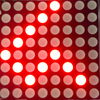A 3x25mm Tritium tube can be purchased online, which contains an estimated ~3 GBq (decay/second) of Tritium gas. This glows green in the dark. By using a small (very important to ensure usable voltage), amorphous solar cell from a cheap calculator and a simple reflector it will produce around 1.6V (measured via capacitor charge) and around 50 nanoamps of current at a constant rate.
This device is not large enough to produce any practical amount of power due to the cost of Tritium tubes. It does, however, approach the power levels of commercial Tritium batteries while costing around 1% of their cost, although being of a larger form factor (something that could be easily shrunk with the help of a 3D printer).
One solar cell was used as opposed to a ring because in practice the single cell produced extremely similar power output when compared to the multiple cell arrangements. This is likely due to the cell having increased efficiency when exposed to brighter light. With multiple cells, the reflector cannot be used and each cell receives less light, resulting in lower efficiency. Due to these findings, one cell was used for simplicity.
UPDATE: In my recent nuclear powered calculator project, I was able to improve upon the design of the Tritium battery. From this, I now recommend that you do not use an altoids box for light shielding and instead use alternate layers of foil and electrical tape, with the foil being the first layer (take care to prevent shorting the cell). This will result in a much more compact and slightly more efficient (1.8 Volts vs. 1.6 Volts on the original) device. The altoids case will still work well for protecting the tube, but using foil as all of the blocking layer will give better reflection and higher power output.
Radiation safety is important, but this project will not produce any dangerous radiation. Tritium decays into a weak Beta particle which is absorbed incredibly easily by the tube walls. This does produce a low energy X-ray due to breaking radiation, but this radiation is quite harmless in these amounts and cannot even be detected with a geiger counter (a scintillation counter would be required for this - from what I have seen, the surface of a Tritium tube of this size produces around 3X background radiation. This is perfectly harmless, and this amount is only right at the surface of the tube). Almost all x-ray radiation produced by this will be absorbed by the glass walls as it will be in the 0-15 keV range. No gamma radiation or alpha radiation is produced. With my CDV-700 geiger counter, no detectable increase in radiation over background is found at the surface of the tube.





Intriguing. Have you considered using something like a PT-54 as the cell? I found that with mine as you might expect they are most sensitive to light slightly shorter than the emission peak. Also for something like this the smaller tubes may be better if more than one is used with its major axis along the long axis of the PT-54 die.